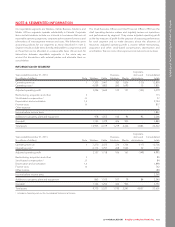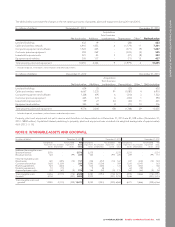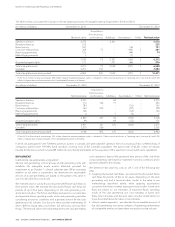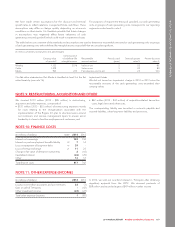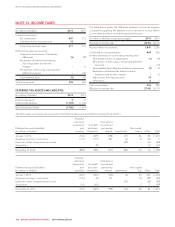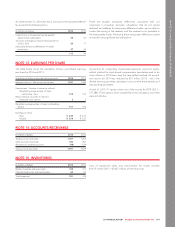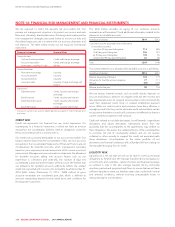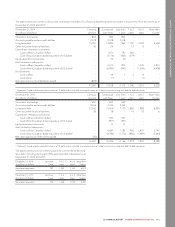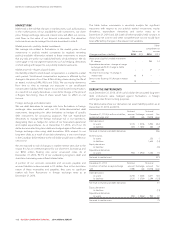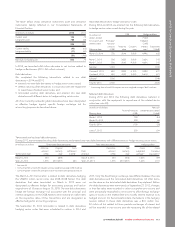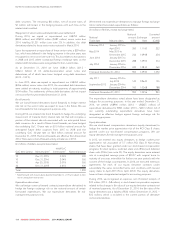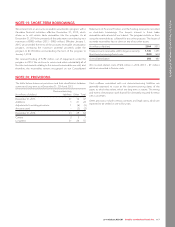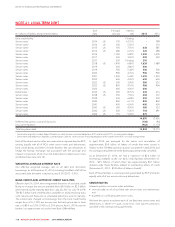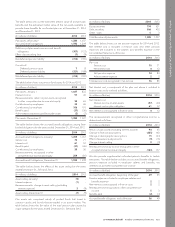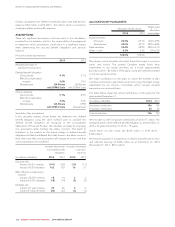Rogers 2014 Annual Report Download - page 116
Download and view the complete annual report
Please find page 116 of the 2014 Rogers annual report below. You can navigate through the pages in the report by either clicking on the pages listed below, or by using the keyword search tool below to find specific information within the annual report.
NOTES TO CONSOLIDATED FINANCIAL STATEMENTS
MARKET RISK
Market risk is the risk that changes in market prices, such as fluctuations
in the market prices of our available-for-sale investments, our share
price, foreign exchange rates and interest rates, will affect our income,
cash flows or the value of our financial instruments. The derivative
instruments we use to manage this risk are described in note 2.
Market price risk – publicly traded investments
We manage risk related to fluctuations in the market prices of our
investments in publicly traded companies by regularly reviewing
publicly available information related to these investments to ensure
that any risks are within our established levels of risk tolerance. We do
not engage in risk management practices such as hedging, derivatives
or short selling with respect to our publicly traded investments.
Market price risk – Rogers Class B shares
Our liability related to stock-based compensation is marked-to-market
each period. Stock-based compensation expense is affected by the
change in the price of our Class B Non-Voting shares during the life of
an award, including SARs, RSUs and DSUs. We use equity derivatives
from time to time to manage our exposure in our stock-based
compensation liability. With respect to our stock-based compensation,
as a result of our equity derivatives, a one dollar change in the price of
a Rogers Non-Voting Class B share would have no effect on net
income.
Foreign exchange and interest rates
We use debt derivatives to manage risksfromfluctuationsinforeign
exchange rates associated with our US dollar-denominated debt
instruments, designating the debt derivatives as hedges of specific
debt instruments for accounting purposes. We use expenditure
derivatives to manage the foreign exchange risk in our operations,
designating them as hedges for certain of our forecasted operational
and capital expenditures. As at December 31, 2014, all of our US
dollar-denominated long-term debt was hedged against fluctuations in
foreign exchange rates using debt derivatives. With respect to our
long-term debt, as a result of our debt derivatives, a one cent change
in the Canadian dollar relative to the US dollar would have no effect on
net income.
We are exposed to risk of changes in market interest rates due to the
impact this has on interest expense for our short-term borrowings and
our $250 million floating rate senior unsecured notes. As at
December 31, 2014, 92.7% of our outstanding long-term debt and
short-term borrowings was at fixed interest rates.
A portion of our accounts receivable and accounts payable and
accrued liabilities is denominated in US dollars. Due to the short-term
nature of these receivables and payables, they carry no significant
market risk from fluctuations in foreign exchange rates as at
December 31, 2014.
The table below summarizes a sensitivity analysis for significant
exposures with respect to our publicly traded investments, equity
derivatives, expenditure derivatives and senior notes as at
December 31, 2014 and 2013 with all other variables held constant. It
shows how net income and other comprehensive income would have
been affected by changes in the relevant risk variables.
Net income
Other
comprehensive
income
(Change in millions of dollars) 2014 2013 2014 2013
Share price of publicly traded investments
$1 change ––14 14
Expenditure derivatives – change in foreign
exchange rate $0.01 change in Cdn$
relative to US$ ––77
Short-term borrowings 1% change in
interest rates 64––
Senior notes (floating) 1% change in interest
rates 2–––
DERIVATIVE INSTRUMENTS
As at December 31, 2014, all of our US dollar-denominated long-term
debt instruments were hedged against fluctuations in foreign
exchange rates for accounting purposes.
The tables below show our derivatives net asset (liability) position as at
December 31, 2014 and 2013.
December 31, 2014 (In millions of dollars,
except exchange rate)
Notional
amount
(US$)
Exchange
rate
Notional
amount
(Cdn$)
Fair
value
Debt derivatives:
As assets 5,725 1.0396 5,952 853
As liabilities 305 1.1857 362 (7)
Netmark-to-marketassetdebtderivatives 846
Bond forwards:
As assets 250 1
As liabilities 1,650 (14)
Equity derivatives:
As liabilities (30)
Expenditure derivatives:
As assets 960 1.0940 1,050 70
Net mark-to-market asset 873
December 31, 2013
(In millions of dollars, except exchange
rate)
Notional
amount
(US$)
Exchange
rate
Notional
amount
(Cdn$)
Fair
value
Debt derivatives:
As assets 4,250 1.0285 4,371 184
As liabilities 2,130 1.0769 2,294 (133)
Netmark-to-marketassetdebtderivatives 51
Equity derivatives:
As liabilities (13)
Expenditure derivatives:
As assets 900 1.0262 923 37
Net mark-to-market asset 75
112 ROGERS COMMUNICATIONS INC. 2014 ANNUAL REPORT



